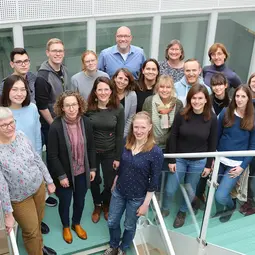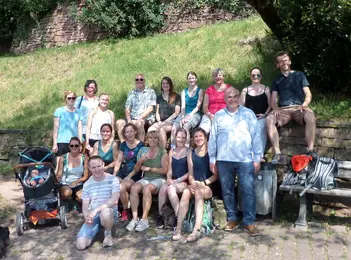Infections and Cancer Epidemiology
- Epidemiology, Public Health, Prevention and Survivorship

Dr. Tim Waterboer
Head of Division
The central aim of the Division is the discovery and validation of novel biomarkers for secondary prevention, i.e. screening and early detection of infection-associated cancers, by combining molecular diagnostic approaches with population-based research.

Our Research
About 15% of all cancer cases worldwide are associated with infections. The main etiologic agents are
- Human Papillomaviruses (HPV) which are associated with cervical and other anogenital (e.g. anal) cancers, and head and neck, especially oropharyngeal cancer
- Helicobacter pylori (H. pylori), a bacterium that causes gastric cancer
- Hepatitis B and C viruses (HBV, HCV) which cause hepatocellular carcinoma
- Epstein-Barr virus (EBV) which is associated with Hodgkin’s and Non-Hodgkin’s lymphoma as well as nasopharyngeal carcinoma
- Human Herpesvirus 8 (HHV8), or Kaposi sarcoma-associated herpesvirus (KSHV)
However, most of the infectious agents mentioned above may also cause other cancers, e.g. HPV and non-oropharyngeal head and neck cancer, or H. pylori and other gastrointestinal cancers. Moreover, additional infectious agents have been associated with cancer development, e.g. Chlamydia trachomatis and ovarian cancer.
The central aim of the Division is the secondary prevention, i.e. screening and early detection of infection-associated cancers, and combines molecular diagnostic approaches with population-based research. To this end, we combine high-throughput multiplexed immunoassays and advanced nucleic acid detection systems with data-driven research to discover prognostic and predictive biomarkers (such as antibodies against infectious agents from peripheral blood, or the pathogens’ nucleic acids in liquid biopsies), and to validate them in large epidemiological cohort studies. Our aim is to translate our findings in prospective clinical and screening studies, and to thoroughly evaluate their public health impact.
One central technology in the Division is a high-throughput serological method (“Multiplex Serology”, “Serolomics”), which allows analyzing up to 2000 serum samples per day for antibodies to up to 100 different antigens simultaneously. We collaborate worldwide with many clinical and epidemiological partners to analyze large-scale seroepidemiological studies, and have successfully developed serological assays for all infectious agents mentioned above, and many others. In addition, we develop PCR-based nucleic acid detection methods to evaluate the causality of infections in cancer development, to determine infection-attributable fractions in cancer tissue, and for treatment surveillance of cancer patients (e.g., digital PCR for HPV and EBV from liquid biopsies).
Our Projects
- Human Papillomavirus antibodies and risk of subsequent head and neck cancer
- Serology-based screening for HPV-driven oropharyngeal cancer
- Human papillomavirus cell-free DNA in liquid biopsies for cancer screening and post-therapy monitoring
- Helicobacter pylori and gastrointestinal cancer
- Diagnostic assays for Epstein-Barr virus associated cancers
- Unmasking infection-driven cancers
- China Kadoorie Biobank (CKB) and UK Biobank (UKB)
- SARS-CoV-2 serolomics
High-Throughput Serolomics Lab
sponsored by the Dieter Morszeck Stiftung
Clinical Applications
Oropharyngeal cancer (OPC) caused by human papillomavirus (HPV) affects over 30,000 new patients every year. Currently, there is no reliable test to detect HPV-caused OPC in its early stages. To address this problem, a cross-functional team of scientists and business experts works on the development of an in vitro diagnostic test.
Selected Publications
Nibu KI, Oridate N, Saito Y, Roset M, Forés Maresma M, Cuadras D, Morais E, Roberts C, Chen YT, Spitzer J, Sato K, Saito I, Tazaki I, Clavero O, Schroeder L, Alemany L, Mehanna H, Mirghani H, Giuliano AR, Pavón MA*, Waterboer T*
Kusters JMA, Diergaarde B, Ness A, Schim van der Loeff MF, Heijne JCM, Schroeder L, Hueniken K, McKay JD, Macfarlane GJ, Lagiou P, Lagiou A, Polesel J, Agudo A, Alemany L, Ahrens W, Healy CM, Conway DI, Robinson M, Canova C, Holcátová I, Richiardi L, Znaor A, Pring M, Thomas S, Hayes DN, Liu G, Hung RJ, Brennan P, Olshan AF, Virani S, Waterboer T
Mentzer AJ*, Brenner N*, Allen N, Littlejohns TJ, Chong AY, Cortes A, Almond R, Hill M, Sheard S, McVean G; UKB Infection Advisory Board, Collins R, Hill AVS, Waterboer T
Busch CJ, Hoffmann AS, Viarisio D, Becker BT, Rieckmann T, Betz C, Bender N, Schroeder L, Hussein Y, Petersen E, Jagodzinski A, Schäfer I, Burandt E, Lang Kuhs K, Pawlita M, Waterboer T*, Brenner N*
Ferreiro-Iglesias A, McKay JD, Brenner N, Virani S, Lesseur C, Gaborieau V, Ness AR, Hung RJ, Liu G, Diergaarde B, Olshan AF, Hayes N, Weissler MC, Schroeder L, Bender N, Pawlita M, Thomas S, Pring M, Dudding T, Kanterewicz B, Ferris R, Thomas S, Brhane Y, Díez-Obrero V, Milojevic M, Smith-Byrne K, Mariosa D, Johansson MJ, Herrero R, Boccia S, Cadoni G, Lacko M, Holcátová I, Ahrens W, Lagiou P, Lagiou A, Polesel J, Simonato L, Merletti F, Healy CM, Hansen BT, Nygård M, Conway DI, Wright S, Macfarlane TV, Robinson M, Alemany L, Agudo A, Znaor A, Amos CI, Waterboer T*, Brennan P*
Members of the division have authored more than 400 international,
peer-reviewed publications
Our Team
-
-
-
-
-

Dr. Julia Anna Butt
PostDoc
-
-
-
-
-

Dr. Daniela Höfler
PostDoc
-
-
-
-
-
-
-
-
-
-
-
Maximilian Stich
-
-

Christian Walczuch
Business Development Manager
Press Realeases
SWR Wissen 4. Mai 2023
Auch wenn die Gesamtzahl der Neuerkrankungen gering ist: Immer mehr Menschen in Deutschland erkranken infolge einer HPV-Infektion an Rachenkrebs. Übertragen wird das humane Pampillomvirus – kurz HPV – zum Beispiel durch Oralsex. Manche Forschende reden sogar von einer Epidemie. Fast jeder steckt sich in seinem Leben einmal an, meist schon bei den ersten sexuellen Erfahrungen. More...
DKFZ News 28. September 2022
Screening trials for the early detection of rare diseases often fail due to insufficient predictive power of the results. For the rare HPV-related cancer of the pharynx, scientists from the German Cancer Research Center (Deutsches Krebsforschungszentrum, DKFZ) now relied on the combined detection of antibodies against two different viral proteins in a proof-of concept trial. This enabled them to significantly improve the positive predictive value of the test results. More...
DKFZ News 13. October 2020
Human papilloma viruses (HPV) can cause various tumor diseases, including cancer of the throat. Scientists at the German Cancer Research Center (Deutsches Krebsforschungszentrum, DKFZ) in Heidelberg are now providing evidence that antibodies against certain viral proteins could be an early warning sign of an increased risk of developing throat cancer. More...
DKFZ News 18. May 2020
Mit einer Million Euro fördert die Dieter Morszeck Stiftung am Deutschen Krebsforschungszentrum (DKFZ) den Aufbau einer Hochdurchsatz-Infrastruktur für die serologische Analyse an Blutproben. Die Technologie ermöglicht es, große Personengruppen auf akute oder frühere Infektionen mit Viren oder Bakterien zu untersuchen. Zunächst soll die Plattform eingesetzt werden, um den Nachweis von Antikörpern gegen SARS-CoV-2 und gleichzeitig andere Corona-Viren in großem Maßstab zu ermöglichen. Langfristig soll die Methodik genutzt werden, um zu untersuchen, in wie weit bestimmte Viren und Bakterien mitverantwortlich für die Entstehung von Krebsarten sind. More...
DKFZ News 3. April 2017
A growing number of cases of oropharyngeal cancer are considered to be a consequence of infection with human papillomaviruses (HPV). Scientists at the German Cancer Research Center (DKFZ) have now revealed that a single blood sample test for specific antibodies can identify persons who are at a high risk of developing this type of cancer ten years or more before cancer diagnosis. More ...
Get in touch with us



























